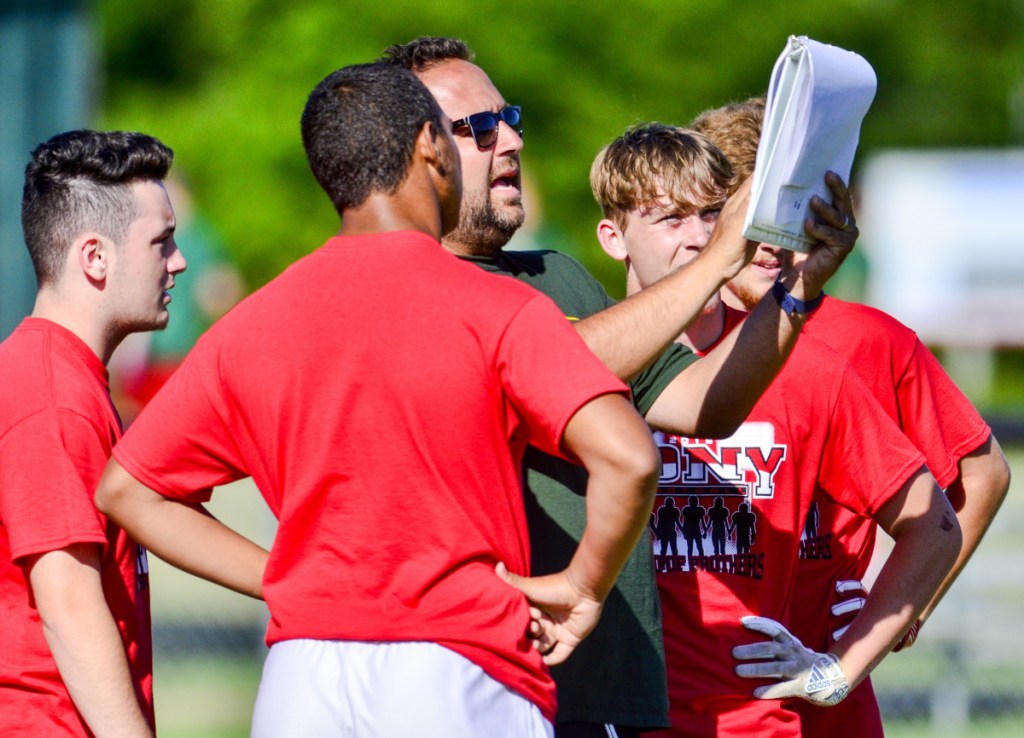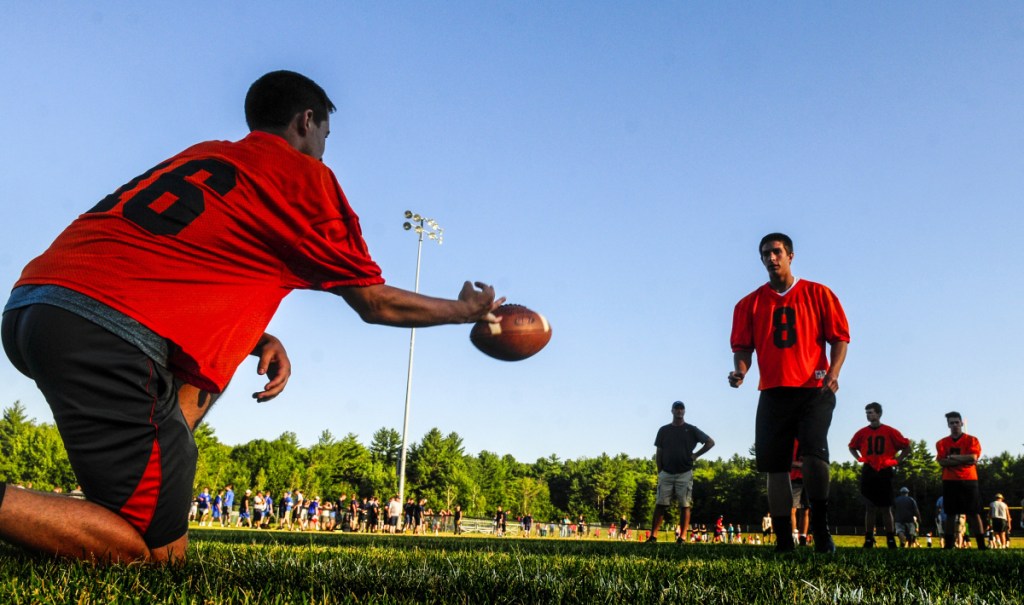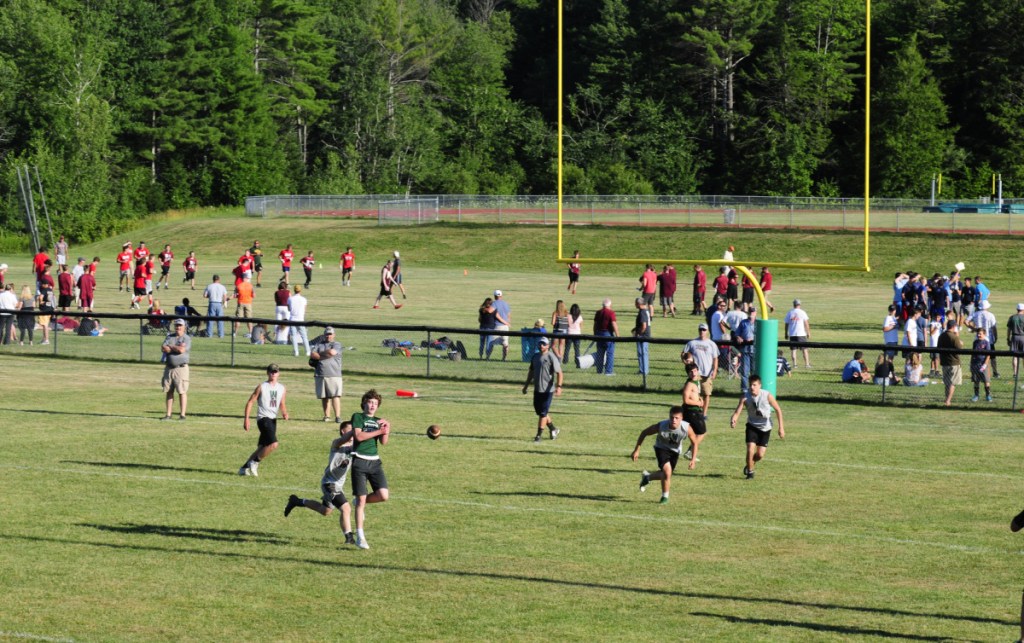TURNER — The Gardiner football team doesn’t throw the ball all that much, so for two years, coach Joe White opted against bringing his squad to Leavitt Area High School for the Hornets’ annual 7-on-7 football sessions.
This year, however, White and the Tigers were back. Nothing’s changed, they’re not planning on slinging the ball around. But they knew they didn’t need a scheme switch to get something from the visit.
“We’re back, more importantly, to get a feel for the game and get some timing down,” White said. “It allows the defense to read and react and practice certain coverages, and if you do it now, it’s in there fresh when you start preseason. You don’t have to spend a whole lot of time reteaching that.”
There’s nothing but passing at 7-on-7s, but not all of the 17 teams that made it are planning on chucking the ball around the field on Friday nights in two months. Sharpening the timing between a quarterback and his receivers is the most obvious benefit, but teams can also practice defending those pass-happy opponents. They can get a head start on filling holes left by graduating playmakers. And they can make sure players know the plays and assignments they’ll need to have down cold come the fall.
There’s something for everyone — whether you’re a team throwing the ball five times a game or 50.
“I would think anyone could benefit from 7-on-7s,” Cony coach B.L. Lippert said. “You still can get better defensively, and whoever your quarterback is, he’s still going to have to make some throws on 3rd-and-10, so you can see which throws he can make, and which throws he should stay away from.
“Nobody wins a spot in 7-on-7 and nobody loses one, but it definitely gets some momentum building for the season.”
There’s no question that spread teams, like Leavitt, Cony and Skowhegan, are the biggest beneficiaries. When you rely on moving the ball through the air, timing is everything, and any opportunity to find a rhythm becomes important.
“We really get to work on our routes and our concepts,” Cony receiver and cornerback Reed Hopkins said. “It gives us a feel for what our team will do in the passing game this year.”
Even teams with checkmarks at the most important positions rely on the early opportunity to see their players in action. Skowhegan returns one of the state’s most prolific passers in Marcus Christopher, but after seeing his most reliable targets graduate, the senior quarterback relished the chance to start grooming his next stable of receivers.
“Especially this year, with a lot of newer receivers, it’s good to build those relationships early on before you get to double sessions and the regular season,” he said. “The biggest thing is learning their speeds, where balls need to be placed on certain routes. … Most of them know the offense, they just need to know me too.”
And for the teams not planning to throw often, they’ll still know how to stop it. Cornerbacks, safeties and linebackers are part of the action just like receivers and quarterbacks are, and coaches want to make sure they’ll know where to be. Maranacook coach Walter Polky briefly lectured his players during a game against Spruce Mountain after a blown assignment left a Phoenix receiver wide open.
“There are some teams that come out, really, solely to play defense against spread offenses,” Lippert said, “because they know they’re going to see two or three of them during the regular season.”
“You get out here, you can see the talent and you can assess other schools in the meantime,” White said. “Look at who they’ve got returning and in general what types of things they might stick into their offensive sets.”
It’s also a chance to evaluate the players running those sets. Player turnover is constant, and while most coaches know who their top players will be, they’re always on the lookout for a surprise standout.
Few teams are a better example than Cony, which graduated its quarterback in Anthony Sousa and its top receivers in Jordan Roddy and Eli Dutil. That makes for a lot of throws and catches to fill, and Lippert said 7-on-7s are a good way to apply for the job.
“We just like seeing our kids get out and compete, because all winter long, (they say) ‘I want to play corner, I want to play linebacker, I think I can be a slot receiver,’ ” he said. “Here’s an opportunity for those kids to show what they can do.”
The Rams’ quarterback race will be a tight one, with Mike Wozniak, Chris Sponsler and Dakota Andow among the top candidates. Wozniak hasn’t played under center at the varsity level, so Friday’s sessions were a chance to get the hang of the position before the real tests start in August and September.
“If I would have started it (in the fall), I would have had my mind set on wide receiver all the way through the summer,” Wozniak said. “(The 7-on-7s) help a lot with play calls and then also timing up my drop back. … There are going to be corners, linebackers that are going to throw off your man. You’ve got to be ready to switch up the timing. This just helps.”
Drew Bonifant — 621-5638
dbonifant@centralmaine.com
Twitter: @dbonifantMTM
Copy the Story LinkSend questions/comments to the editors.






Success. Please wait for the page to reload. If the page does not reload within 5 seconds, please refresh the page.
Enter your email and password to access comments.
Hi, to comment on stories you must . This profile is in addition to your subscription and website login.
Already have a commenting profile? .
Invalid username/password.
Please check your email to confirm and complete your registration.
Only subscribers are eligible to post comments. Please subscribe or login first for digital access. Here’s why.
Use the form below to reset your password. When you've submitted your account email, we will send an email with a reset code.